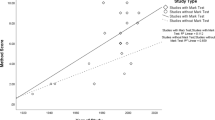Abstract
When a chimpanzee is presented with a mirror it initially responds with social behavior directed toward the reflection. After several hours of exposure to the mirror the social behavior decreases and the mirror is used to guide self-directed responses to previously unobservable parts of the body such as the face. When a distinctively colored mark is unobtrousively applied to the chimpanzee's face and the chimpanzee touches the mark while observing itself in the mirror, this behavior is said to indicate self-recognition. Such self-recognition has been considered to be a robust phenomenon in chimpanzees, with self-directed and mark-directed behaviors both appearing in all socially-housed adult chimpanzees tested. In our study 11 chimpanzees were given mirror exposure and tested with the mark test. Only one of the 11 chimpanzees touched the mark during test, although several showed self-directed behavior using the mirror to guide their movements. Such experimental factors as mirror size, position, or temporal spacing of the mirror exposure, and such subject variables as age, sex, previous social experience, and subspecies were insufficient to explain the difference between the present and previous findings. We suggest that there are individual differences in mirror recognition behavior in chimpanzees, and that further consideration of the factors contributing to this phenomenon, including the development of additional tests for self-recognition, is needed.
Similar content being viewed by others
References
Amsterdam, B., 1972. Mirror image reactions before age two.Develop. Psychobiol., 5: 297–305.
Anderson, J. R., 1984a. Monkeys with mirrors: Some questions for primate psychology.Intern. J. Primatol., 5: 81–98.
————, 1984b. The development of self-recognition: A review.Develop. Psychobiol., 17: 35–49.
————, 1986. Mirror-mediated finding of hidden food by monkeys (Macaca tonkeana andM. fascicularis).J. Comp. Psychol., 100: 237–242.
Baulieu, E.-E., C. Corpechot, F. Dray, R. Emiliozzi, M.-C. Lebeau, P. Mauvais-Jarvis, &P. Robel, 1965. An adrenal-secreted “androgen”-dehydroisoandrosterone sulfate. Its metabolism and a tentative generalization on the metabolism of other steroid conjugates in man. In:Recent Progress in Hormone Research, Vol. 21, Academic Press, New York. pp. 411–500.
Bertenthal, B. I. &K. W. Fischer, 1978. Development of self-recognition in the infant.Develop. Psychol., 14: 44–50.
Bossom, J., 1964. Mechanisms of prism adaptation in normal monkeys.Psychonomic Sci., 1: 377–378.
————, &C. R. Hamilton, 1963. Interocular transfer of prism-altered coordinations in split-brain monkeys.J. Comp. Physiol. Psychol., 56: 769–774.
Brown, W. L., A. A. McDowell, &E. M. Robinson, 1965. Discrimination learning of mirrored cues by rhesus monkeys.J. Genet. Psychol., 106: 123–128.
Calhoun, S. &R. L. Thompson, 1988. Long-term retention of self-recognition by chimpanzees.Amer. J. Primatol., 15: 361–365.
Eglash, A. R. &C. T. Snowdon, 1983. Mirror-image responses in pygmy marmosets (Cebuella pygmaea).Amer. J. Primatol., 5: 211–219.
Epstein, R., R. P. Lanza, &B. F. Skinner, 1981. “Self-awareness” in the pigeon.Science, 212: 695–696.
Flook, J. P. &B. O. McGonigle, 1977. Serial adaptation to conflicting prismatic rearrangement effects in monkey and man.Perception, 6: 15–29.
Gallup, G. G., Jr., 1970. Chimpanzees: self-recognition.Science, 167: 86–87.
————, 1977a. Absence of self-recognition if a monkey (Macaca fascicularis) following prolonged exposure to a mirror.Develop. Psychobiol., 10: 281–284.
————, 1977b. Self-recognition in primates: A comparative approach to the bidirectional properties of consciousness.Amer. Psychol., 32: 329–338.
————, 1979. Self-recognition in chimpanzees and man: A developmental and comparative perspective. In:The Child and Its Family,M. Lewis &L. A. Rosenblum (eds.), plenum Press, New York, pp. 107–126.
————, 1982. Self-awareness and the emergence of mind in primates.Amer. J. Primatol., 2: 237–248.
————,M. K. McClure, S. D. Hill, &R. A. Bundy, 1971. Capacity for self-recognition in differentially reared chimpanzees.Psychol. Record, 21: 69–74.
———— &S. D. Suarez, 1986. Self-awareness and the emergence of mind in humans and other primates. In:Psychological Perspectives on The Self, Vol. 3,J. Suls &A. Greenwald (eds.), Erlbaum, Hillsdale, New Jersey, pp. 3–26.
————,L. B. Wallnau, &S. D. Suarez, 1980. Failure to find self-recognition in mother-infant and infant-infant rhesus monkey pairs.Folia Primatol., 33: 210–219.
Hamilton, C. R., S. B. Tieman, &B. A. Brody, 1973. Interhemispheric comparison of mirror image stimuli in chiasm-sectioned monkeys.Brain Res., 58: 415–425.
Hill, S. D., R. A. Bundy, G. G. Gallup, Jr., &M. K. McClure, 1970. Responsiveness of young nursery reared chimpanzees to mirrors.Proceed. Louisiana Acad. Sci., 33: 77–82.
Itakura, S., 1987a. Mirror guided behavior in Japanese monkeys (Macaca fuscata fuscata).Primates, 28: 149–161.
————, 1987b. Use of a mirror to direct their responses in Japanese monkeys (Macaca fuscata fuscata).Primates, 28: 343–352.
Johnson, D. B., 1983. Self-recognition in infants.Inf. Behav. Develop., 6: 211–222.
Ledbetter, D. H. &J. A. Basen, 1982. Failure to demonstrate self-recognition in gorillas.Amer. J. Primatol., 2: 307–310.
Lethmate, J. &G. Ducker, 1973. Untersuchungen zum Selbsterkennen im Spiegel bei Orang-utans und einigen anderen Affenarten.Z. Tierpsychol., 33: 248–269.
Lewis, M. &J. Brooks-Gunn, 1979.Social Cognition and the Acquisition of Self. Plenum, New York.
Menzel, E. W., Jr., E. S. Savage-Rumbaugh, &J. Lawson, 1985. Chimpanzee (Pan troglodytes) spatial problem solving with the use of mirrors and televised equivalents of mirrors.J. Comp. Psychol., 99: 211–217.
Robert, S., 1986. Ontogeny of mirror behavior in two species of great apes.Amer. J. Primatol., 10: 109–117.
Suarez, S. D. &G. G. Gallup, Jr., 1981. Self-recognition in chimpanzees and orangutans, but not gorillas.J. Human Evol., 10: 175–188.
Swartz, K. B., 1990. The concept of mind in comparative psychology.Ann. N. Y. Acad. Sci., 602: 105–111.
Author information
Authors and Affiliations
About this article
Cite this article
Swartz, K.B., Evans, S. Not all chimpanzees (Pan troglodytes) show self-recognition. Primates 32, 483–496 (1991). https://doi.org/10.1007/BF02381939
Received:
Accepted:
Issue Date:
DOI: https://doi.org/10.1007/BF02381939




